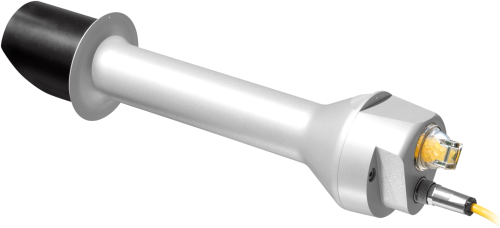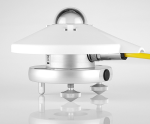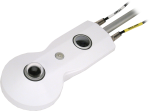






Overview
The CHP1-L, manufactured by Kipp & Zonen and cabled by Campbell Scientific, is a pyrheliometer used for unattended direct solar-radiation measurements. It is designed specifically to measure the direct beam solar irradiance with a field of view limited to 5 degrees. This is achieved by the shape of the collimation tube, precision apertures, and the detector design.
Read MoreBenefits and Features
- ISO First Class
- Built-in temperature sensors
Images

Technical Description
To monitor direct normal irradiance, a CHP1 Pyrheliometer is mounted to a user-supplied sun tracker such as Kipp & Zonen's Solys2. The CHP1 pyrheliometer measures the direct-beam solar irradiance with a field of view limited to 5 degrees. The limited field of view requires the CHP1 to be continuously pointed toward the sun. The Solys2 Sun Tracker rotates on two axes and uses a GPS receiver to keep the CHP1 aimed at the sun throughout the day.
Compatibility
Please note: The following shows notable compatibility information. It is not a comprehensive list of all compatible products.
Specifications
| Spectral Range | 200 to 4000 nm |
| Sensitivity | 7 to 14 µV/W/m2 |
| Response Time | < 5 s |
| Zero Offset B | < 1 W/m2 |
| Temperature Dependence of Sensitivity | < 0.5% (-20° to +50°C) |
| Field of View (FOV) | 5° ±0.2° |
| Operating Temperature Range | -40° to +80°C |
| Non-Linearity | < 0.2% |
| Maximum Irradiance | 4000 W/m2 |
| International Standards | First Class ISO |
| Body Diameter | 3.8 cm (1.5 in.) |
| Base Diameter | 7.6 cm (3.0 in.) |
| Length | 31.6 cm (12.4 in.) |
| Weight | 0.9 kg (1.98 lb) excluding cable |
Related Documents
Product Brochures
Related FAQs
Number of FAQs related to CHP1-L: 11
Expand AllCollapse All
-
Ideally, the window should be cleaned every morning.
-
Every two years.
-
Yes, but only under certain conditions. The most common condition for a negative output signal occurs during nighttime measurements when the temperature of space is less than the sensor’s temperature.
-
Absolutely. Because the CHP1-L measures the direct beam solar irradiance, it must follow the sun and remain within the limits of the 5 degree field of view to provide accurate measurements.
-
The CHP1-L is typically mounted to a user-supplied sun tracker, such as Kipp & Zonen’s Solys2 or EKO Instruments’ STR-21G/22G.
-
The CHP1-L is a pyrheliometer, manufactured by Kipp & Zonen, that measures the direct beam irradiance from the sun within a 5 degree solid angle around the sun.
-
A pyrheliometer, such as the CHP1-L, has a window through which sunlight enters. The sunlight, or incident solar short-wave radiation, is directed onto an electronic device called a thermopile. Using the thermoelectric effect, the thermopile acts as a large thermocouple that measures the temperature of a particular body—in this case, the sun. The thermal energy is converted into a voltage output signal that can be recorded by Campbell Scientific dataloggers.
-
Yes. The internal temperature can be measured using either the PT100 or thermistor built into the sensor.
-
Most Campbell Scientific sensors are available as an –L, which indicates a user-specified cable length. If a sensor is listed as an –LX model (where “X” is some other character), that sensor’s cable has a user-specified length, but it terminates with a specific connector for a unique system:
- An –LC model has a user-specified cable length for connection to an ET107, CS110, or retired Metdata1.
- An –LQ model has a user-specified cable length for connection to a RAWS-P weather station.
If a sensor does not have an –L or other –LX designation after the main model number, the sensor has a set cable length. The cable length is listed at the end of the Description field on the product’s Ordering tab. For example, the 034B-ET model has a description of “Met One Wind Set for ET Station, 67 inch Cable.” Products with a set cable length terminate, as a default, with pigtails.
If a cable terminates with a special connector for a unique system, the end of the model number designates which system. For example, the 034B-ET model designates the sensor as a 034B for an ET107 system.
- –ET models terminate with the connector for an ET107 weather station.
- –ETM models terminate with the connector for an ET107 weather station, but they also include a special system mounting, which is often convenient when purchasing a replacement part.
- –QD models terminate with the connector for a RAWS-F Quick Deployment Station.
- –PW models terminate with the connector for a PWENC or pre-wired system.



